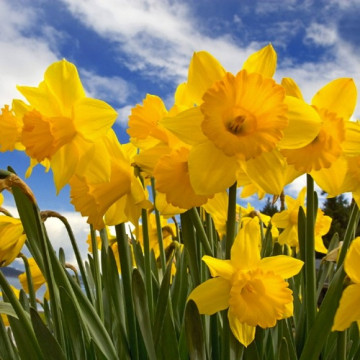Our Environment: “Amazing Daffodils” by Scott Turner
Saturday, March 28, 2020
Yellow was the color of our first full week of coronavirus self-distancing.
In Providence, daffodils of various shades of yellow (and some white) signaled the arrival of spring. The daffodils supplemented crocuses that had bloomed a few days earlier. Most of the daffodils opened in bunches—like bright sunshine bursting from the ground.
Meanwhile, in the shrub canopy, forsythia unveiled a deep yellow at eye level. Also blooming among the shrubbery was the slightly paler yellow (and smaller) flowers of Cornelian cherry. This new wave of color significantly augmented the golden glow of winter-blooming witch hazels, which will now fade, as temperatures warm.
GET THE LATEST BREAKING NEWS HERE -- SIGN UP FOR GOLOCAL FREE DAILY EBLASTIn the wilder landscape, there wasn’t much new in terms of color, with browns and grays still dominating. It was the change in sounds, though, that told us spring was afoot.
Strolling the Ten Mile Greenway from East Providence to Pawtucket, and back, Karen and I heard first-of-the-year wood frogs, chorally “quacking” from the edge and shallow water of a small pond.
A little further along the path, we listened to the start-and-stop calling of spring peepers. These little frogs were in a fairly extensive, cattail-marked wetland. One little frog would start peeping, and others would join in, until they’d all cease at a sound such as a child shouting or a dog barking.
For both wood frogs and spring peepers, it is only the males that call, and they do it as part of mating behavior.
As you probably know, North America has lost nearly 3 billion birds over the last 50 years. In my 43 years of birdwatching, I’ve discerned a distinct (and very sad) decline in bird sounds and sightings. On the walk, we did hear the calls of Blacked-capped Chickadee and Tufted Titmouse, and the melancholy song of a Mourning Dove.
From the shoreline of James V. Turner Reservoir came the chattering of a Belted Kingfisher. This fish-eating species migrates when water ices over, with a few scattered birds hanging around through winter. We took the call as another sign of spring.
Even more so was the sighting of an Osprey hitting the water amidst a bevy of Mute Swans on the reservoir. This was our first Osprey sighting of the year (the species heads south in fall), and we were impressed at how large this fish-eating hawk seemed and how beautifully its brown back and wings contrasted with its white underparts and brown-and-white-head.
We were also dazzled by how such a big creature could plummet from the sky into shallow water and rise out from its splashy submersion with a nice-sized fish, which to our limited piscine knowledge looked like a crappie.
By the way, this is Mute Swan mating season. That may have accounted for some of the vocalizations coming the birds (they’re not mute), including croaks and snorts. Also, and maybe this was a sign of territorial behavior, a swan would occasionally charge another, and one, the other, or both would take off over the water in short, swift water-surface-wing-smacking runs.
Strolling on the sunny streets and in the out-of-doors on the chilly afternoons of late March was a way to forget the darkness and dreariness of pandemic life.
From social distancing to fighting fear, we need to stick to the plan, so that, in words crooned by the late Eddie Kendricks, we “Keep on truckin, baby.”
Scott Turner is a Providence-based writer and communications professional. For more than a decade he wrote for the Providence Journal and we welcome him to GoLocalProv.com.
Related Articles
- Our Environment: “A Trek Through Cranberry Vines” by Scott Turner
- Our Environment: “The Trail Untraveled” by Scott Turner
- Our Environment: “The American Robin Arrives” by Scott Turner
- Our Environment: “Skunked” by Scott Turner
- Our Environment: “Finding Solace in Southern Maine” by by Scott Turner
- Our Environment: “The Pigeons of Yankee Stadium” by Scott Turner
- Our Environment: “The Waka-Waka Wake Up Call” by Scott Turner
- Our Environment: “Rejuvenating Break on Our Journey” by Scott Turner
- Our Environment: “The Original Peeps” by Scott Turner
- Our Environment: “Crickets & The Coming of Fall” by Scott Turner
- Our Environment: “A Moment of Tranquility” by Scott Turner
- Our Environment: “Obituary for a Swamp White Oak Tree” by Scott Turner
- Our Environment: “The Winter Sun” by Scott Turner
- Our Environment: “The Colors of Winter” by Scott Turner
- Our Environment: “Blooming in Brooklyn” by Scott Turner
- Our Environment: “Gone Tree, Gone” by Scott Turner
- Our Environment: “The Big Walk” by Scott Turner
- Our Environment: “Touring the Rockies” by Scott Turner
- Our Environment: “Redwoods Are Like Giant Shrines to Life” by Scott Turner
- Our Environment: “Sunsets at Salter Grove” by Scott Turner
- Our Environment: “Snowbirds Arrive” by Scott Turner
- Our Environment: “The Coast of Northern California” by Scott Turner
- Our Environment: “Big Sur & the California Condors” by Scott Turner
- Our Environment: “The Gano Escape” by Scott Turner




